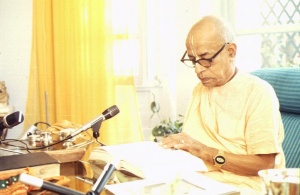CC Madhya 20.333: Difference between revisions
m (1 revision(s)) |
No edit summary |
||
| Line 1: | Line 1: | ||
{{ | [[Category:Sri Caitanya-caritamrta - Madhya-lila Chapter 20|C333]] | ||
<div style="float:left">'''[[Sri Caitanya-caritamrta|Śrī Caitanya-caritāmṛta]] - [[CC Madhya|Madhya-līlā]] - [[CC Madhya 20|Chapter 20: Lord Śrī Caitanya Mahāprabhu Instructs Sanātana Gosvāmī in the Science of the Absolute Truth]]'''</div> | |||
<div style="float:right">[[File:Go-previous.png|link=CC Madhya 20.332|Madhya-līlā 20.332]] '''[[CC Madhya 20.332|Madhya-līlā 20.332]] - [[CC Madhya 20.334|Madhya-līlā 20.334]]''' [[File:Go-next.png|link=CC Madhya 20.334|Madhya-līlā 20.334]]</div> | |||
{{CompareVersions|CC|Madhya 20.333|CC 1975|CC 1996}} | |||
{{RandomImage}} | |||
==== TEXT 333 ==== | ==== TEXT 333 ==== | ||
<div | <div class="verse"> | ||
tretāyāṁ rakta-varṇo ’sau | :tretāyāṁ rakta-varṇo ’sau | ||
catur-bāhus tri-mekhalaḥ | :catur-bāhus tri-mekhalaḥ | ||
hiraṇya-keśas trayy-ātmā | :hiraṇya-keśas trayy-ātmā | ||
sruk-sruvādy-upalakṣaṇaḥ | :sruk-sruvādy-upalakṣaṇaḥ | ||
</div> | </div> | ||
| Line 14: | Line 18: | ||
==== SYNONYMS ==== | ==== SYNONYMS ==== | ||
<div | <div class="synonyms"> | ||
''tretāyām''—in Tretā-yuga; ''rakta-varṇaḥ''—of a reddish color; ''asau''—He; ''catuḥ-bāhuḥ''—with four arms; ''tri-mekhalaḥ''—having three circles on the abdomen; ''hiraṇya-keśaḥ''—hair colored like gold; ''trayī-ātmā''—whose form manifests the ''Vedas''; ''sruk-sruva-ādi-upalakṣaṇaḥ''—decorated with the sacrificial spoon, ladle and so on. | |||
</div> | </div> | ||
| Line 21: | Line 25: | ||
==== TRANSLATION ==== | ==== TRANSLATION ==== | ||
<div | <div class="translation"> | ||
“‘In Tretā-yuga, the Lord appeared in a body that had a reddish hue and four arms. There were three distinctive lines on His abdomen, and His hair was golden. His form manifested the Vedic knowledge, and He bore the symbols of a sacrificial spoon, ladle and so on.’ | “‘In Tretā-yuga, the Lord appeared in a body that had a reddish hue and four arms. There were three distinctive lines on His abdomen, and His hair was golden. His form manifested the Vedic knowledge, and He bore the symbols of a sacrificial spoon, ladle and so on.’ | ||
</div> | </div> | ||
__NOTOC__ | |||
<div style="float:right; clear:both;">[[File:Go-previous.png|link=CC Madhya 20.332|Madhya-līlā 20.332]] '''[[CC Madhya 20.332|Madhya-līlā 20.332]] - [[CC Madhya 20.334|Madhya-līlā 20.334]]''' [[File:Go-next.png|link=CC Madhya 20.334|Madhya-līlā 20.334]]</div> | |||
__NOTOC__ | |||
__NOEDITSECTION__ | |||
Revision as of 16:10, 7 September 2021
Śrī Caitanya-caritāmṛta - Madhya-līlā - Chapter 20: Lord Śrī Caitanya Mahāprabhu Instructs Sanātana Gosvāmī in the Science of the Absolute Truth

His Divine Grace
A.C. Bhaktivedanta Swami Prabhupada
A.C. Bhaktivedanta Swami Prabhupada
TEXT 333
- tretāyāṁ rakta-varṇo ’sau
- catur-bāhus tri-mekhalaḥ
- hiraṇya-keśas trayy-ātmā
- sruk-sruvādy-upalakṣaṇaḥ
SYNONYMS
tretāyām—in Tretā-yuga; rakta-varṇaḥ—of a reddish color; asau—He; catuḥ-bāhuḥ—with four arms; tri-mekhalaḥ—having three circles on the abdomen; hiraṇya-keśaḥ—hair colored like gold; trayī-ātmā—whose form manifests the Vedas; sruk-sruva-ādi-upalakṣaṇaḥ—decorated with the sacrificial spoon, ladle and so on.
TRANSLATION
“‘In Tretā-yuga, the Lord appeared in a body that had a reddish hue and four arms. There were three distinctive lines on His abdomen, and His hair was golden. His form manifested the Vedic knowledge, and He bore the symbols of a sacrificial spoon, ladle and so on.’